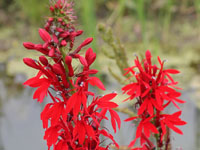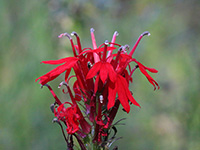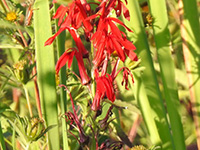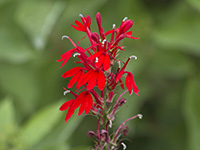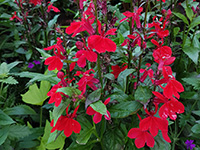![]()
Cardinal Flower (Lobelia cardinalis) is a strikingly beautiful flowering plant native to North America, particularly thriving in wetlands, stream banks, and moist meadows across the continent. It belongs to the Lobelia genus, a group of plants known for their tubular, vividly colored flowers and medicinal properties. Among its close relatives along the East Coast are Indian Tobacco (Lobelia inflata) and Great Blue Lobelia (Lobelia siphilitica). These three species share distinctive botanical features, including a prominent "lip" petal that extends near the flower’s opening and the production of a characteristic milky latex, a white sap excreted when the plant is damaged.
Cardinal Flower is best known for its brilliant scarlet-red blooms, which make it a favorite among gardeners and a valuable source of nectar for hummingbirds, its primary pollinators. The plant’s vibrant color and unique floral structure are not only visually captivating but also serve to attract specific pollinators that are well-adapted to its deep tubular flowers. The species was introduced to Europe in the mid-1620s, where it quickly drew attention for its ornamental value. By 1629, it was commonly referred to as the "cardinal flower," a name inspired by the intense red color of the blossoms, which closely resembles the crimson robes worn by Roman Catholic cardinals. This association with ecclesiastical attire helped cement its name in the horticultural vocabulary of the time.
The genus name, Lobelia, honors Matthias de L'Obel (1538–1616), a renowned Belgian botanist and physician who made significant contributions to plant classification and early botanical literature. His work helped lay the foundation for modern botany, and his name lives on through this vivid and elegant plant. Today, Cardinal Flower remains a favorite in native plant gardens, pollinator habitats, and restoration projects, admired not only for its beauty but also for its historical and ecological significance.
![]()
Plants in the Lobelia family (genus Lobelia) have attracted growing scientific interest due to their pharmacologically active compounds, which show promising potential in the treatment of neurological disorders. Several species in this genus, particularly Lobelia inflata (commonly known as Indian tobacco), contain lobeline, an alkaloid that has demonstrated a range of effects on the central and peripheral nervous systems.
Lobeline is structurally and functionally similar to nicotine and has been shown to interact with nicotinic acetylcholine receptors (nAChRs) in the brain. This interaction can influence dopamine release, a neurotransmitter critically involved in mood regulation, motor control, addiction, and cognitive function. Because of these mechanisms, lobeline has been explored as a potential therapeutic agent for a variety of neurological and psychiatric conditions.
In addition to lobeline, other secondary metabolites found in various Lobelia species are being studied for their neuroprotective, anti-inflammatory, and antispasmodic properties, all of which are relevant to treating chronic neurological diseases. While early laboratory and animal studies have shown promise, the use of lobelia-derived compounds in clinical medicine is still under investigation. Research is ongoing to better understand their mechanisms of action, optimal dosages, potential side effects, and long-term safety profiles. Importantly, despite its therapeutic potential, lobeline and other alkaloids in lobelia can be toxic in high doses, and unsupervised use is not recommended.
![]() Within both rational and holistic medicine, Cardinal Flower has long been valued for its medicinal properties, particularly among North American Indigenous peoples, who used various parts of the plant to treat a wide range of ailments. The roots of the Cardinal Flower were commonly prepared as an ingredient in herbal teas, especially for the treatment of intestinal disorders and syphilis, conditions for which few reliable remedies existed prior to modern medicine. These root infusions were used to support digestive health, reduce inflammation, and potentially act as a cleansing agent for internal infections. The leaves were also employed in traditional medicine, often brewed into teas to relieve respiratory issues such as bronchial congestion, coughs, and colds. In addition to these uses, the leaves were included in remedies for a variety of ailments, reflecting their broad therapeutic application.
Within both rational and holistic medicine, Cardinal Flower has long been valued for its medicinal properties, particularly among North American Indigenous peoples, who used various parts of the plant to treat a wide range of ailments. The roots of the Cardinal Flower were commonly prepared as an ingredient in herbal teas, especially for the treatment of intestinal disorders and syphilis, conditions for which few reliable remedies existed prior to modern medicine. These root infusions were used to support digestive health, reduce inflammation, and potentially act as a cleansing agent for internal infections. The leaves were also employed in traditional medicine, often brewed into teas to relieve respiratory issues such as bronchial congestion, coughs, and colds. In addition to these uses, the leaves were included in remedies for a variety of ailments, reflecting their broad therapeutic application.
Among specific Indigenous groups, unique uses of the plant were recorded. The Meskwaki people, for example, utilized Cardinal Flower as part of an inhalant to relieve catarrh, a condition involving excessive mucus in the nose or throat, often associated with respiratory infections and inflammation. The Penobscot people used the dried leaves as a tobacco substitute, either smoking them ceremonially or recreationally. It is also believed that the leaves may have been chewed, possibly for similar psychoactive or soothing effects, though documentation on this practice is limited. The Zuni people applied Cardinal Flower externally, using it to treat rheumatism and localized swelling. In such cases, the plant was likely made into a poultice or wash, taking advantage of its anti-inflammatory properties to ease joint pain and reduce inflammation in affected areas.
Though modern use of Lobelia cardinalis in herbal medicine is limited, largely due to the plant’s potent alkaloids, its historical significance in Indigenous healing systems highlights its importance as a traditional remedy. These diverse applications—ranging from internal cleansing to respiratory relief, and from external anti-inflammatory treatment to ceremonial use, reflect the plant’s respected role in cultural and medicinal practices throughout North America.
Please note that MIROFOSS does not suggest in any way that plants should be used in place of proper medical and psychological care. This information is provided here as a reference only.
![]()
The plant contains a number of alkaloids. As a member of the genus Lobelia, it is considered to be POTENTIALLY TOXIC. The Zuni people use this plant as an ingredient of "schumaakwe cakes".
Please note that MIROFOSS can not take any responsibility for any adverse effects from the consumption of plant species which are found in the wild. This information is provided here as a reference only.
![]()
Cardinal Flower is a moisture-loving perennial that thrives in rich, fertile soils, making it an ideal choice for rain gardens, wet meadows, and streamside plantings. It is highly adaptable when it comes to soil composition and can grow well in both medium (loamy) and heavy (clay) soils, as long as the conditions remain consistently moist to wet. In fact, this plant is so moisture-dependent that it can even grow in shallow aquatic environments, such as the edges of ponds, marshes, or slow-moving streams, where its roots may be partially submerged.
In cultivation, Cardinal Flower performs best in deep, organically rich soils that retain moisture year-round. Soil that dries out for extended periods will cause the plant to decline, especially during its active growing and flowering season. Gardeners often amend soil with compost or leaf mold to increase moisture retention and enrich its nutrient content, supporting vigorous growth and vibrant blooms.
Cardinal Flower is tolerant of a wide pH range, and it can grow in acidic, neutral, or alkaline (basic) soils, adding to its versatility in a variety of garden and naturalistic settings. In terms of light requirements, full sun is generally preferred, especially in cooler climates, as it promotes robust growth and prolific flowering. However, Cardinal Flower can also grow in partial shade, particularly in warmer regions where some afternoon shade can help protect the plant from excessive heat and moisture loss. In woodland edge gardens or lightly shaded wet areas, it can still thrive if the soil remains adequately moist.
Because of its preference for moist environments and its spectacular red flowers that attract hummingbirds and butterflies, Cardinal Flower is a favorite in pollinator gardens, wildlife habitats, and naturalized wetland restorations. Its adaptability to a variety of soil types and light conditions, combined with its love of water, makes it a standout species for enhancing biodiversity and visual interest in damp or challenging areas of the landscape.
| Soil Conditions | |
| Soil Moisture | |
| Sunlight | |
| Notes: |
![]()
Cardinal Flower is a perennial herbaceous plant prized for its showy red flowers and preference for moist, wetland habitats. It typically grows up to 120 centimeters (about 4 feet) tall and is commonly found in damp environments such as stream banks, swamps, marsh edges, and along freshwater shorelines, where the soil remains consistently moist. The plant features alternately arranged leaves that are lanceolate to ovate (oval-shaped), measuring up to 20 centimeters long and 5 centimeters wide. The leaf margins are usually toothed (serrated), and the leaves are often a deep green, forming an attractive backdrop to the brilliant blooms that appear above.
Cardinal Flower produces strikingly vibrant red flowers, which are its most recognizable and ornamental feature. Each bloom is deeply five-lobed and measures up to 4 centimeters across. The flowers are arranged in a tall, upright cluster known as a raceme, which can extend up to 70 centimeters high, creating a dramatic floral spike. Blooming typically occurs from mid-summer through early fall, providing a rich source of nectar when many other plants have finished flowering.
The flowers are specifically adapted for pollination by hummingbirds, particularly the ruby-throated hummingbird, which is the plant’s primary pollinator. The tubular shape of the blooms, combined with their vivid red color, a hue especially attractive to hummingbirds, encourages cross-pollination as the birds feed on nectar and transfer pollen from flower to flower.
Propagation is relatively simple, as Cardinal Flower produces numerous tiny seeds, which develop inside capsule-shaped seed pods about 5 millimeters in length. Once mature, the capsules release the seeds, which fall to the ground around the parent plant. These seeds readily germinate under the right moisture conditions, giving rise to young plants that cluster around older, established individuals. Over time, this self-seeding behavior can lead to attractive natural colonies in suitable habitats. Although it is classified as a perennial, Cardinal Flower is often described as short-lived, especially if growing conditions are less than ideal. Regular reseeding, either naturally or by the gardener, helps maintain populations over time. Its beauty, ecological importance, and role in supporting pollinators make Cardinal Flower a valuable addition to native plant gardens, wetland restorations, and pollinator-friendly landscapes.
![]()
| Plant Height | 120cm |  |
| Habitat | Swamps, Moist Forests, Stream banks | |
| Leaves | Alternate, Lanceolate 20cm long | |
| Leaf Margin | Toothed | |
| Leaf Venation | Pinnate | |
| Stems | Smooth Stems | |
| Flowering Season | July to September | |
| Flower Type | Elongated clusters of deeply lobed flowers | |
| Flower Colour | red | |
| Pollination | Insects, hummingbirds | |
| Flower Gender | Flowers are hermaphrodite and the plants are self-fertile | |
| Fruit | Capsule shaped seeds | |
| USDA Zone | 4B (-28°C to -31°C) cold weather limit |
![]()
The following health hazards should be noted when handling or choosing a location to cardinal flower:
 |
TOXICITY Cardinal Flower contains a number of alkaloids. As a member of the genus Lobelia, it is considered to be potentially toxic. |
 |
SKIN IRRITANT |
![]()
 |
-Click here- or on the thumbnail image to see an artist rendering, from The United States Department of Agriculture, of cardinal flower. (This image will open in a new browser tab) |
![]()
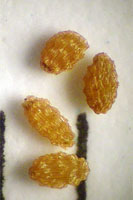 |
-Click here- or on the thumbnail image to see a magnified view, from Minnesota Wildflowers, of the seeds created by cardinal flower for propagation. (This image will open in a new browser tab) |
![]()
Cardinal Flower can be referenced in certain current and historical texts under the following name:

![]()
 |
What's this? What can I do with it? |
![]()
| Dickinson, T.; Metsger, D.; Bull, J.; & Dickinson, R. (2004) ROM Field Guide to Wildflowers of Ontario, Royal Ontario Museum, Toronto:McClelland and Stewart Ltd. | |
| Kartesz, J.T. 1994. A synonymized checklist of the vascular flora of the United States, Canada, and Greenland. 2nd edition. 2 vols. Timber Press, Portland, OR. | |
| Felpin F.-X., Lebreton J. , "History, chemistry and biology of alkaloids from Lobelia inflata" Tetrahedron 2004 60:45 (10127-10153) | |
| Foster, Steven and James A. Duke. Eastern/Central Medicinal Plants. Peterson Field Guides, Houghton, Mifflin 1990 edn. ISBN 0-395-92066-3 | |
| Caruso, C. M.; Peterson, S. B.; Ridley, C. E. (2003), "Natural selection on floral traits of Lobelia (Lobeliaceae): spatial and temporal variation", American Journal of Botany 90 (9): 1333–40, doi:10.3732/ajb.90.9.1333, PMID 21659233 | |
| Frances Tenenbaum (2003). Taylor's Encyclopedia of Garden Plants. Houghton Mifflin Harcourt. pp. 244–. ISBN 0-618-22644-3. | |
| Stevenson, Matilda Coxe 1915 Ethnobotany of the Zuni Indians. SI-BAE Annual Report #30 (p. 56) | |
| USDA-NRCS PLANTS Database / USDA NRCS. Wetland flora: Field office illustrated guide to plant species. USDA Natural Resources Conservation Service. | |
| National Audubon Society. Field Guide To Wildflowers (Eastern Region): Alfred A. Knopf. ISBN 0-375-40232-2 | |
| National Audubon Society. Field Guide To Wildflowers (Eastern Region): Alfred A. Knopf. ISBN 0-375-40232-2 | |
| May 31, 2025 | The last time this page was updated |
| ©2025 MIROFOSS™ Foundation | |
 |
|

